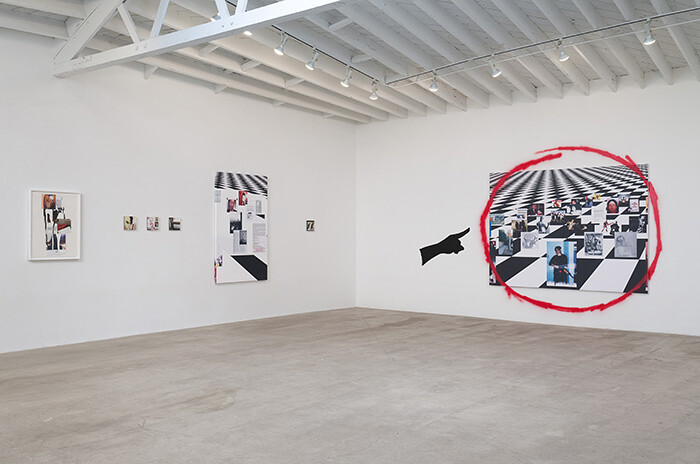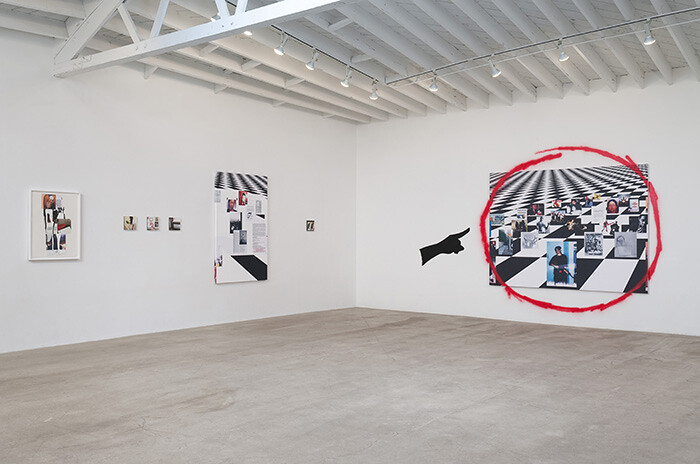About three years ago, something unexpected happened in Frances Stark’s art. After two decades of making work about herself—about her anxieties and obsessions, her identity crises and motivational struggles—she started making work about other people. Stranger still, her subjects became, in most instances, young men of color.
Stark’s current exhibition “Bobby Jesus’s Alma Mater” features a body of work begun in 2012 when a young Hispanic man by the name of Bobby—a friend of a man she met at her son’s skate park in Los Angeles—became her unlikely muse. Around the same time she was becoming disillusioned with her job as tenured professor at the University of Southern California’s Roski School of Art and Design. Her frustration turned to outrage in 2013 when the university announced that the school would be subsumed by the new 70 million dollar Academy of Arts, Technology and the Business of Innovation, funded by music producer Dr. Dre and his business partner Jimmy Iovine. Stark vented her anger in a major and widely acclaimed video installation, Bobby Jesus’s Alma Mater b/w Reading the Book of David and/or Paying Attention is Free (2013), which she first showed at the 2013 Carnegie International in Pittsburgh. The video introduced us to Bobby (“AKA ANDREW / AKA DREW / NÉE ANDRÉS / AKA G. BUSINESS”) and laid out reams of research material relating to gang culture, her preadolescent son’s beloved hip-hop music, art history, Christian theology, and the US educational and prison systems. It was a furious and polemical work. The exhibition “Bobby Jesus’s Alma Mater” at Marc Foxx does not include this large-scale installation, but instead reproduces sections of the printed background onto which Stark originally projected a video of text and music. This panorama incorporated 81 found images relating to the project; those wishing to follow Stark down her rabbit hole of thematic associations could make use of an annotated plan of the imagery printed on the back of a series of free posters the Carnegie Museum of Art made available. In the current installation, Stark has instead printed parts of the background image onto canvas-effect plastic (yuk) and stretched them as if they were paintings. She has used spray paint to edit out extraneous material and to make more direct connections, or contrasts, between particular elements.
One such quasi-painting—a diptych, titled Bobby Jesus’s Alma Mater, passage from a movement therein: la puta madre (2014)—presents a sequence of images that runs from Gustave Courbet’s L’Origine du Monde [The Origin of the World] (1866) to a photograph of two gang-members (a Crip and a Blood) fighting on a Los Angeles street. Between them are images that include an etching by Austrian artist Anton Lehmden (b. 1929) of the ruined and distinctly vaginal Colosseum (1959–61), a photograph of a Roman centurion mascot at the USC Trojans football stadium (known as the Coliseum), and paintings of Christians being slaughtered for entertainment in the Roman Coliseum. Gangsters, she seems to imply, kill each other today for our entertainment; motherhood—a metaphor for the pedagogical system, and its failures (Alma mater, of course, literally means “nurturing mother” while puta madre is usually translated as “mother fucker”)—is the arena in which this tragedy unfolds.
Between these large panels is a series of small, square prints, exported directly from Stark’s Instagram account—@therealstarkiller—and mounted behind heavy Plexiglas as if to compensate for their lack of conceptual and/or visual heft. Some of the images are personal, like a screenshot of Stark’s texts to her son (“Everyday I’m hustling…”), while others reproduce images from books or snaps of the artist’s work hung in someone’s home. (Hers?) To say that these reference images—some found and some photographed by the artist—are minor works is not necessarily pejorative; Stark has tools both powerful and delicate in her arsenal, and both have their uses. These pictures are supporting material, evidence that Stark’s grand thesis on race, class, sex, motherhood, business, and pedagogy is affirmed everywhere she looks.
Where Bobby Jesus’s Alma Mater b/w Reading the Book of David and/or Paying Attention is Free was rhizomatic in its presentation of information, this exhibition is broadly linear. It demands to be read from left to right, around the room. It begins with a portrait of DJ Quik, a contemporary of Dr. Dre whose career, though influential, was less stellar, but whose music and stated commitment to “art for art’s sake” has featured prominently in Stark’s project to date. With a triangular button superimposed over his face, the artist directs us: Press play and listen. In the 2013 installation, one got the sense that she was working through this material alongside us. In this exhibition, however, we are being lectured.
Ordinarily, I am happy to be lectured to by Stark. (She has used the pedagogical format to exhilarating effect in the past.) But there is a creeping sense here that we are moving into conspiracy-theory territory, via some over-zealous implications of cause and effect. A network of associations is hard to unpick, and easy to enmesh oneself within. A chain, on the other hand, is only as strong as each of its links. Some of these connections seem rather pat, and what’s more, they rely on Stark’s singular perspective as a mother teaching at USC. (Swap L.A. for New York, or USC for UCLA or NYU, and it makes no sense.) Despite appearances, we realize that Stark is no less present in this work than she is in any of her prior confessional monologs. Perhaps that is why critics, to date, have given her a relatively easy ride on the racial dynamics of this project: at its basis, it is about a middle-class, highly educated, white woman coming to terms with aspects of African-American and Hispanic male culture in the city in which she lives. She is not claiming to speak for anyone except herself.











